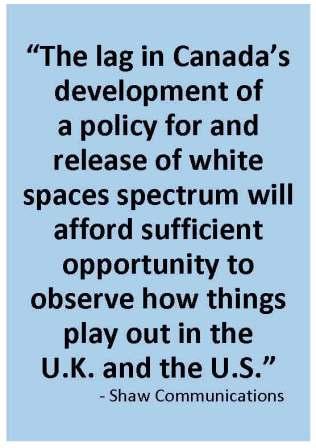
OTTAWA – Some companies are telling Industry Canada that it shouldn’t rush to open up TV white spaces spectrum, while another is saying let’s get on with it.
In reply comments to the consultation (that we first reported on here), the majority urges the department to consider all the pros and cons, ensure over-the-air TV isn’t negatively affected and watch how rollouts in other markets go before making a final decision on how it’s going to proceed. They say this will best ensure Canada gets it right.
As was argued by several parties in initial comments, Bragg Communications reiterates that there is “no pressing need” and that it would be best to observe the rollout of white spaces devices (WSD) in the U.S. and the U.K before making a final decision on how to deploy it here. (White spaces are considered to be the unused spectrum in between TV channels once used only by technology such as garage door openers, but it can be used for wireless broadband. And since it is low frequency spectrum, it can travel far longer distances and can be more robust than Wi-Fi with the ability to better-penetrate walls.)
Rogers Communications urges caution before moving forward on WSDs to ensure that cable headends, over-the-air (OTA) broadcasting and low-power applications such as wireless microphones are adequately protected interference. All reasonable measures should “be taken to prevent harmful interference caused by white space devices from disrupting BDU and over-the-air TV broadcast systems,” it writes, noting that lower power applications should also be afforded protection.
Shaw Communications says that while caution should be exercised in establishing rules for WSDs, it doesn’t mean Canada should sit and wait for other markets to roll out their WSDs before making any decisions. There is already sufficient delay in the Canadian government’s process on TV white spaces spectrum to ensure it benefits from the experiences in the U.S. and the U.K., the company argues. “As it stands today, the lag in Canada’s development of a policy for and release of white spaces spectrum will afford sufficient opportunity to observe how things play out in the U.K. and the U.S.,” says Shaw, adding “the government should adopt a spectrum policy that allows such innovation and choice to flourish rather than being satisfied with the status quo.”

In its reply comments, Shaw also says that the current Remote Rural Broadband Service (RRBS) regime (which is fixed wireless) should be phased out and incorporated into a new policy on TV white spaces spectrum. “This is best achieved by grandfathering existing RRBSs for a specified period of time so that they can migrate over to a licence exempt, centralized database regime,” the company writes.
When it comes to interference mitigation with existing users (OTA broadcasting and wireless microphones), most companies note that registration databases offer the best solution at the moment. While spectrum sensing may work in the future, it’s currently unproven.
Rogers refers to mobile broadband gear manufacturer Telcordia’s comments in highlighting its position. “The database is the last and only available mechanism to quickly control or remove from service devices that could otherwise generate harmful interference. It is therefore vital that any database that is implemented for this purpose be secure and available 100% of the time to support associated technical rules to prevent harmful interference,” Rogers says.
Several parties suggest that Industry Canada become directly involved in managing and maintaining the database to ensure its integrity. Shaw is an outlier, arguing instead for a competitive, market-driven approach. The company notes, however, that the department should “adopt technical rules for WSDs and centralized registration databases,” so it can address harmful interference if need be and ensure that a market-based method won’t impose too great of a cost on operators.
There were suggestions in comments that Industry Canada allow for highly mobile and vehicle-mounted WSDs. Microphone and other audio electronics manufacturer Shure Inc. vehemently opposes that, noting that if allowed, this could lead to a “nightmare scenario” for wireless microphone users.
“A single vehicle passing by a sports stadium or theatre district with a white space device transmitting but unable to interact in real time with the database to update its list of available channels for its rapidly changing locations has the potential to cause massive interference to the multiple wireless microphones operating in the area,” the company tells the department.



